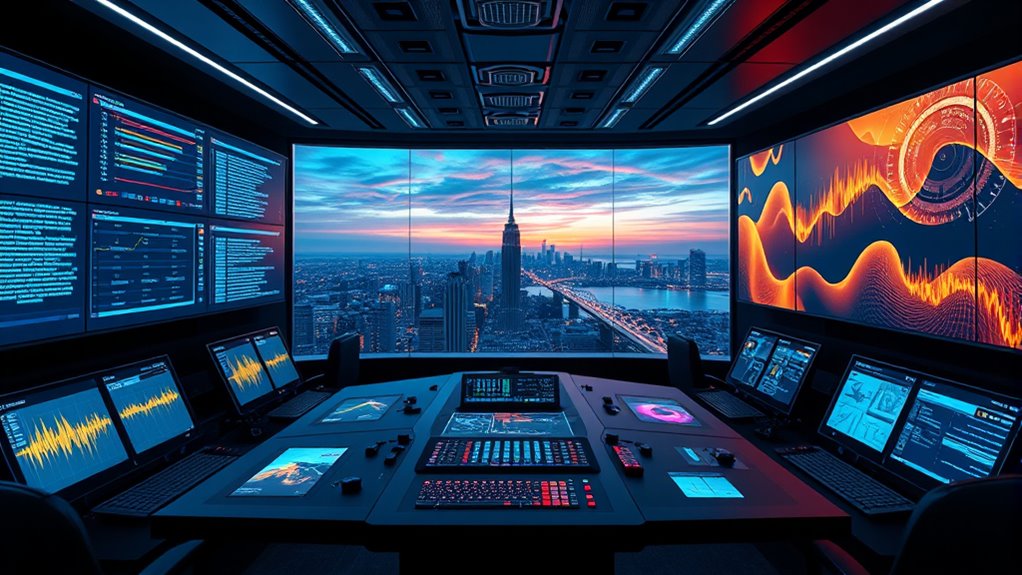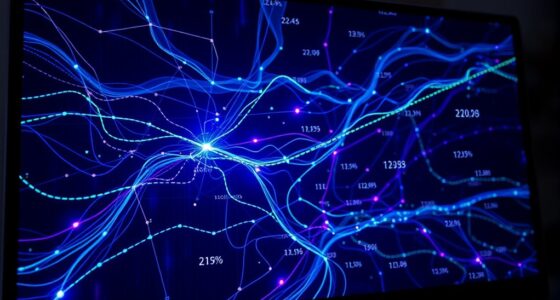Multimodal ISR models fuse text, audio, and imagery to give you a clearer picture of complex situations. By combining multiple data sources in real-time, these systems improve threat detection, movement tracking, and environment understanding. They use machine learning to link visual cues, spoken words, and written reports, creating a more complete picture. If you keep exploring, you’ll find how these advanced techniques enhance intelligence gathering and decision-making in various operational scenarios.
Key Takeaways
- Multimodal ISR models integrate text, audio, and imagery for comprehensive situational awareness and threat detection.
- These systems combine data sources in real-time, enabling synchronized analysis across multiple modalities.
- Deep learning techniques extract and align features from diverse data types for cross-modal reasoning.
- Customization allows systems to focus on specific environments or operational needs, improving accuracy.
- Fusion of multiple data streams enhances insights, reduces false alarms, and supports smarter decision-making.

Have you ever wondered how modern intelligence systems process complex information from multiple sources? It’s a fascinating blend of technology and strategy that allows these systems to make sense of vast, diverse datasets. Multimodal ISR (Intelligence, Surveillance, and Reconnaissance) models are at the forefront of this effort, integrating text, audio, and imagery to generate a thorough understanding of situations. Instead of relying on a single type of data, these models fuse information from different sources, providing a richer, more accurate picture. This integration boosts the system’s ability to identify threats, track movements, and interpret environments with greater precision.
Modern intelligence systems analyze and fuse diverse data sources for comprehensive situational awareness.
Imagine you’re analyzing an intelligence scenario where you have satellite images, intercepted audio communications, and written reports. Traditional systems might process each data type separately, leading to fragmented insights. Multimodal models, however, combine these inputs in real-time, allowing you to correlate visual patterns with audio cues and textual information. This synthesis helps you recognize complex patterns that might be missed if you only looked at one data stream. For instance, a satellite image might show unusual activity at a location, while intercepted audio might reveal corroborating conversations, and reports could provide contextual details. When these are fused, your understanding becomes more nuanced and actionable.
These models leverage advanced machine learning techniques, such as deep neural networks, to understand the unique features of each modality. They use specialized algorithms to extract meaningful features from images, transcribe and interpret spoken words, and analyze text for intent and context. Then, they align these features within a shared representational space, enabling cross-modal reasoning. This process allows the system to, for example, link a suspicious image with relevant audio chatter and corresponding textual reports, creating a multi-dimensional understanding that surpasses single-modality analysis.
You also benefit from the adaptability of multimodal ISR models, which can be tailored to specific operational needs. Whether you’re monitoring urban environments, border crossings, or open seas, these systems can be configured to prioritize certain data types or focus on particular threat indicators. Their ability to learn from new data ensures continuous improvement, making them more effective over time. This fusion of diverse data sources not only enhances detection and classification accuracy but also reduces false alarms, providing you with more reliable intelligence.
In essence, these models empower you to see the bigger picture by weaving together different threads of information. They turn raw data into strategic insights, enabling smarter decisions in complex, dynamic environments. As technology advances, the integration of text, audio, and imagery in multimodal ISR models will become even more seamless and sophisticated, transforming how intelligence is gathered, processed, and acted upon.
Frequently Asked Questions
How Do Multimodal ISR Models Handle Conflicting Information From Different Modalities?
When you encounter conflicting information from different modalities, multimodal ISR models prioritize based on context, confidence scores, or the reliability of each modality. They actively weigh the inputs, often using attention mechanisms, to discern which source is more trustworthy. This way, you get a coherent response that synthesizes the most relevant and accurate information, even when modalities disagree, ensuring effective and reliable interpretation.
What Are the Main Challenges in Integrating Real-Time Audio and Visual Data?
Imagine juggling flaming torches—you’re balancing real-time audio and visual data, which is no small feat. The main challenges you face include syncing data streams with different latencies, managing noise and inaccuracies, and ensuring rapid processing without losing critical details. You need robust algorithms that adapt quickly, filter out irrelevant info, and keep the system synchronized, so your real-time insights stay accurate and reliable amidst the chaos.
How Scalable Are These Models for Large-Scale Deployment?
These models are becoming increasingly scalable for large-scale deployment, but challenges remain. You’ll need significant computational resources and optimized algorithms to handle vast amounts of data efficiently. Cloud infrastructure and distributed processing help, but costs and latency can be hurdles. With ongoing advancements, you can expect better scalability, enabling deployment across diverse industries. However, continuous refinement is vital to guarantee consistent performance and manage resource demands effectively.
What Are the Privacy Concerns Associated With Multimodal Data Collection?
Imagine you’re collecting voice, image, and text data for a health app. Privacy concerns arise because sensitive information like medical details or personal images could be mishandled or leaked. You need to guarantee data is securely stored, anonymized when possible, and only used with explicit consent. Failing to do so risks breaches, loss of trust, and potential legal consequences. Protecting user privacy must be a top priority in multimodal data collection.
How Do Multimodal ISR Models Perform Across Diverse Languages and Cultures?
You’ll find that multimodal ISR models perform variably across languages and cultures due to differences in speech patterns, gestures, and visual cues. They often excel in data-rich environments but struggle with less-represented languages or cultural expressions. To improve performance, you should focus on diverse training datasets, incorporate cultural context, and continually adapt models to better understand linguistic and cultural nuances across global populations.
Conclusion
By integrating text, audio, and imagery, you harness the full potential of multimodal ISR models. You enhance understanding, improve accuracy, and enable more responsive interactions. You combine diverse data streams, leverage complementary insights, and push the boundaries of what’s possible. You innovate with adaptability, foster richer communication, and open new possibilities. Ultimately, you shape smarter systems that see, hear, and interpret the world more like humans do, paving the way for a more connected and intelligent future.









